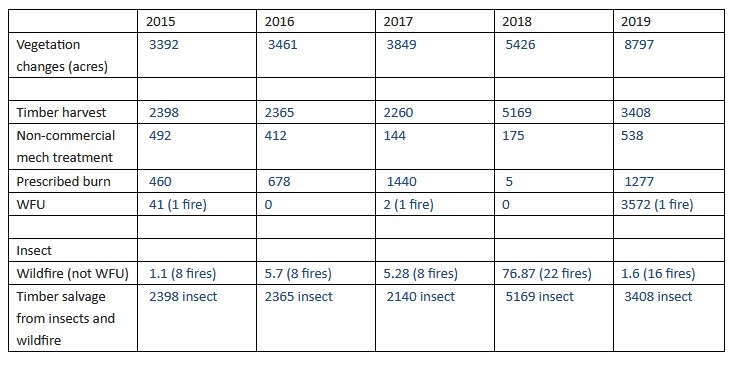I remember Chris Iverson, noted expert in wildlife and forest planning, saying something once about forest plans like “if you don’t do much, you shouldn’t spend as much time planning.” As I recall, he was talking about the Chugach compared to the Tongass forest plans. But what exactly is “doing much”? What seems to be most controversial and widespread is vegetation management for forest management.
I thought it would be interesting to see where the Rio Grande (with a recent plan revision) fell on that scale, and many thanks to them for their help in collecting this information. I think it would be great to have this information available for all forests. First, the total acres of the Rio Grande is 1.83 million acres to give context. You could easily do this table with percentages and be able to compare the acres impacted by management across different National Forests, as well as vegetation changes due to human and other factors.
What we got from the Forest was total acres of all vegetation treatments, not duplicating the same acres with different treatments (double counting).
According to the forest, the average timber harvest has been around 3100 acres per year. All of that has been insect salvage except for 120 acres in 2017. So that’s about 2% of the forest per year. Of course, salvaging spruce beetle trees that are dead may have different impacts than green sales, but this table is about all acres impacted by vegetation management and other vegetation change.
After collecting this information, I realized that a 10 year timespan may have been better. In 2013, the West Fork Complex Fire burned 87,662 acres of the Rio Grande. Then there’s the spruce beetle outbreak itself over time, accumulating to 617,000 acres. I didn’t fill in that row in the table, but the information is available from the aerial survey folks.
It would be interesting to see at least 10 years with the acreage by type plotted over time, including large events like bug and fire acres, for each National Forest. I think it would be very informative to compare forests, both in total acres of different kinds of human and other vegetation changes, and percentages of the total acres impacted.
I’m not saying that this is the perfect formulation for people to get a grasp of “relative vegetation management” I’m just asking “doesn’t this way of looking at it tell us something of value”?
What would you add or change?
Also circling back to the forest planning question, if some forests, say in R5, have had up to 80 % of their forest affected by wildfires over the past 5 to 10 years, should everyone else stop planning so that they can go into revision? And if “fires are going to get larger due to some combination of fire suppression, increased ignitions and climate change” should then the amount of vegetation modeling done during plan revision be scaled back for fire-prone Forests as not a great investment? Perhaps less energy on modeling and more energy on responding to fire and other changes via amendment?

NFMA says: “… the Secretary shall assure that such plans … be revised … from time to time when the Secretary finds conditions in a unit have significantly changed …” I’m not sure a secretary has ever found that, but I don’t think there would be much argument that burning up 80% of the forest would qualify. Its old plan would probably be pretty useless then.
Of course if that means they will not be implementing any projects, then nobody will be challenging them (or the plan) and it won’t matter that their plan is useless, so giving it a low priority for revision could make sense.
On the other hand, here’s what the Ninth Circuit said when a forest tried to implement vegetation management projects under somewhat similar circumstances:
“The Monitoring Report indicates that a “changed condition” occurs when the Forest Service’s approach to a particular management issue no longer complies with the Forest Act. Monitoring Report Question D demonstrates that a changed condition has indeed occurred for the two old growth management indicator species, the red-backed vole and the pileated woodpecker. Therefore there is no doubt that the Forest Service’s management of these two species does not comply with the law. Despite the Forest Service’s statement that viability for old growth species is not threatened in the short term, a changed condition has occurred and this changed condition has placed its management of old growth dependent species out of compliance with the Forest Act—in other words not in accordance with law.”
https://scholar.google.com/scholar_case?case=5700842999305475198&q=rittenhouse&hl=en&as_sdt=3,27